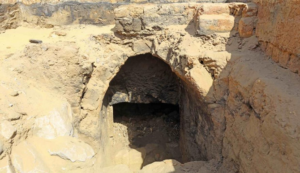According to the University of Milan, a joint Egyptian-Italian Mission excavating near Aswan in Egypt has discovered a tomb from the Greco-Roman period containing twenty mummies.
Excavations were conducted by the University of Milan and the Supreme Council of Antiquities (SCA), in which the researchers have been studying the area around the Mausoleum of Aga Khan III. The mausoleum was constructed in 1956 on the site of an ancient necropolis, containing over 300 tombs from the 6th century BC to the 4th century AD.
The archaeologists uncovered a large family tomb (called AGH032) that was looted by grave robbers in antiquity, but still contains twenty mummies dating from the Greco-Roman period.
The tomb was obscured by a rectangular structure that shows traces of burning, in addition to a landfill of animal bones, pottery fragments, offering tables and plates inscribed in hieroglyphics.
Near the structure’s eastern wall, a mummy was revealed along with a copper necklace and a plaque engraved in Greek that mentions the name “Nikostratos”, which was likely removed from the tomb by grave robbers searching for valuables.
Pope Benedict XVI knew about sexual abuse of children by priests, an inquest finds
The tomb itself has an entrance room where the researchers found a terracotta sarcophagus containing the mummy of a child and a cartonnage, a type of ancient Egyptian funerary mask made of layers of linen or papyrus covered with plaster.
The room leads to four burial chambers cut from the natural bedrock in which the majority of mummies were placed, although several burials show evidence of looting from the bandages and cartonnage being cut by ancient thieves.
Ask me anything
Explore related questions





